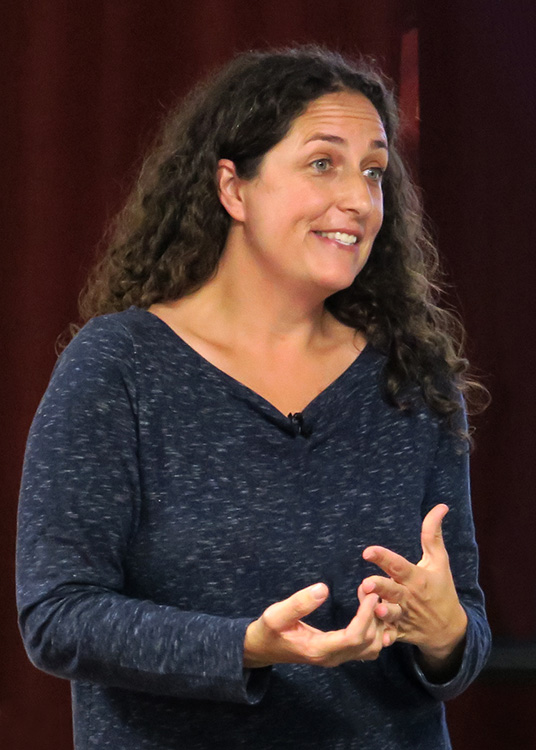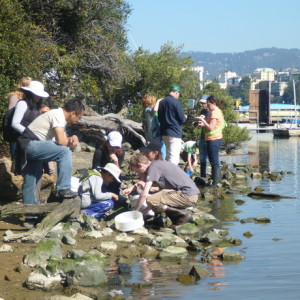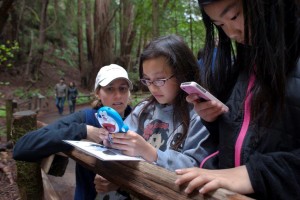Monday, October 26, 2015

Dr. Rebecca Johnson, an invertebrate biologist and the co-coordinator of citizen science research at the California Academy of Sciences, described how ordinary people all over the world are helping to conduct scientific research. They do routine tasks any layperson can do, such as collecting soil samples and classifying galaxies according to their shapes. In the Bay Area, people are doing citizen science also by discovering and documenting the city’s biodiversity in their backyards, local parks, sidewalk gardens, and walks to school or work. Maybe it won’t save the world, but maybe it will. After listening to Rebecca (engaging, upbeat, matter-of-fact, and queen of the nudibranchs), it was hard not to feel better about our chances.
It is nice to be needed, and it turns out that scientists need us non-scientists. They need our numbers and our laypersons’ perspectives. Thanks to 21st century technology, they are getting both. Armies of citizen scientists are doing the field work of science (sometimes without leaving their homes) by making observations, recording and reporting them, and even analyzing them. Such crowd-sourcing democratizes data collection, interpretation, and analysis, improves public understanding of science, builds natural history skills, connects people to the natural world, fosters stewardship, strengthens our sense of place, and builds community. How much better can you get?
Thanks in part to continuing advances in technology, which have allowed scientists to use tools they could not even have imagined only a few years ago, the possibilities for citizen science are only growing. For a catalog of citizen science projects and an easy on-ramp to getting involved, check Zooniverse.
Rebecca shared some of her favorite citizen science projects. (1) Using foldit, an online computer game, participants made a breakthrough in HIV research by discovering in just three weeks how a certain enzyme works. (2) In 2006, Jilene and Jonathan Penhale (aged 11 and 10 respectively), found a species that scientists had feared was extinct. Participating in a project to survey ladybug populations, the kids collected a nine-spotted ladybug, the first sighting of the species in the eastern U.S. in over 14 years. The Lost Ladybug Project is going strong — citizen scientists (including many kids) helping scientists better understand ladybugs by recording sightings of them. As of November 2015, the ladybug followers had produced more than 34,000 sightings. (3) On Galaxy Zoo, 150,000 people produced 50 million galaxy classifications in one year, including 70,000 in the project’s first hour of operation. (4) Watching Neptune Canada’s live video of the ocean floor off Vancouver Island, a 14-year-old boy in the Ukraine saw an elephant seal (which he initially called “some monster”) eating a hagfish — the first time a seal had ever been seen doing it. (5) Using e-Bird, bird watchers all over the world report their bird sightings — more than 9.5 million in a single month in 2015. (6) Using Snapshot Serengeti, citizen scientists monitor camera traps in Tanzania’s Serengeti National Park, helping scientists record and classify the many species of wildlife in the park.
Through her work at the Academy, Rebecca is helping to build a community of naturalists discovering nature in their everyday lives. Among other things, Rebecca works with citizen scientists to discover, document, and monitor invertebrates and seaweeds in the intertidal habitats of central California. Here are the findings of one such project, at Pillar Point on the San Mateo coast. The project has tracked starfish wasting disease at Pillar Point, part of a greater inquiry into that devastating disease. Starfish are an important part of an intertidal community, and their decimation may be an indication of climate change in operation.
One form of citizen science is the bio-blitz, an intensive one-day effort to identify and record as many species as possible in a particular area. In addition to raising the awareness of participants about the wide diversity of species in the targeted area, a bio-blitz collects data that can help scientists better understand and manage the area. Using smartphones and an online platform called iNaturalist, bio-blitzers record and share their findings, as they did in this recent bio-blitz of McLaren Park. This Chronicle article describes a 2014 bio-blitz of Oakland’s Lake Merritt—a project Rebecca helped coordinate.


In September 2015, the White House Office of Science and Technology Policy hosted a conference on citizen science in an effort to promote it. Scientists are not only using citizen science but studying it and discussing how to use it better. Citizen science is expanding to the social sciences. Maybe citizen science won’t save the world, or maybe it has already begun to.
For more on citizen science and Rebecca’s role in promoting it, see this article in Hoodline: “Cal Academy’s Dr. Rebecca Johnson Talks Bay Area Citizen Science.”